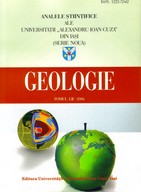The point of zero charge (pHPZC) for titanium dioxide reported in the literature cover almost all pH domain, from 2 to almost 9. In this paper, we used the acid-base titration method to determined the pHPZC for a TiO2 sample. Results obtained for three different electrolite solutions show that value of point of zero charge is 5.5, in a very good correlation with the data from the literature.

English title
- SERIA
GEOLOGIE (AUI-G) - |

|
| Log in New account |
| Home | Main Page | Guide for Authors | Peer Review | New Articles | Events | Archive | Index | Contact us |

|
Article DETERMINATION OF SURFACE CHARGE FOR METAL OXIDES
Traian Gavriloaiei - „Al.I.Cuza” University of Iaşi, Romania, Department of Geology Doina-Iuliana Gavriloaiei - Technical College of Electronics and Telecommunications, Iaşi, Romania View abstract as pdf file | View full article as pdf file Abstract: The behavior of aqueous dispersion of inorganic oxides is of great importance in industrial and laboratory applications. Point of zero charge is of fundamental importance in surface sciences; for example, in the field of environmental science, it determines how easily a solid substrate is able to adsorb potentially ions. It also has applications in colloids science, e.g., flotation of minerals. Point of zero charge (pHPZC) for a given oxide surface is the pH value at which it surface has a net neutral charge. The significance of the pHPZC value is that a given oxide surface will have a positive charge in the acid pH domain (and the value is less than the point of zero charge) and a negative charge in the alkaline pH domain.
Keywords: point of zero charge, titanium dioxide, acid-base titration method |
copyright © 2024 Department of Geology |